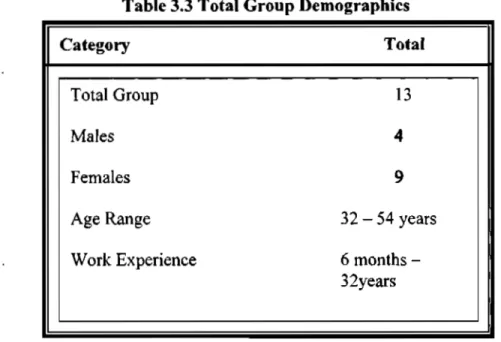This study is situated in the field of adult education in general with a particular focus on workplace learning. This study examines four research questions: How do employees perceive the atmosphere for creativity in the workplace?; How is a creative climate fostered or stifled at the workplace?; What does 'creative climate' mean?; What are the key success factors for fostering and enabling a creative climate at Thekwini FET College.
CHAPTER ONE
INTRODUCTION AND OVERVIEW
INTRODUCTION
BACKGROUND OF THE STUDY Further Education and Training in South Africa
In 2001, in accordance with the Further Education and Training Act 1998, Cato Manor Technical College, Durban Central Technical College and LC Johnson Technical College merged to form Thekwini FET College, a public further education and training institution according to the KwaZulu-Natal Government Gazette . No. Strategic partnerships are being established to access further education and training opportunities with other FET providers, higher education (HE) institutions, organized labour, the community, relevant government departments and non-governmental organisations, business and industry, small , medium-sized, micro organizations. Enterprise (SMMEs) and Sector Education Training Authority (SETAs), a body that plans and controls education and training within a particular sector on the basis of rules.
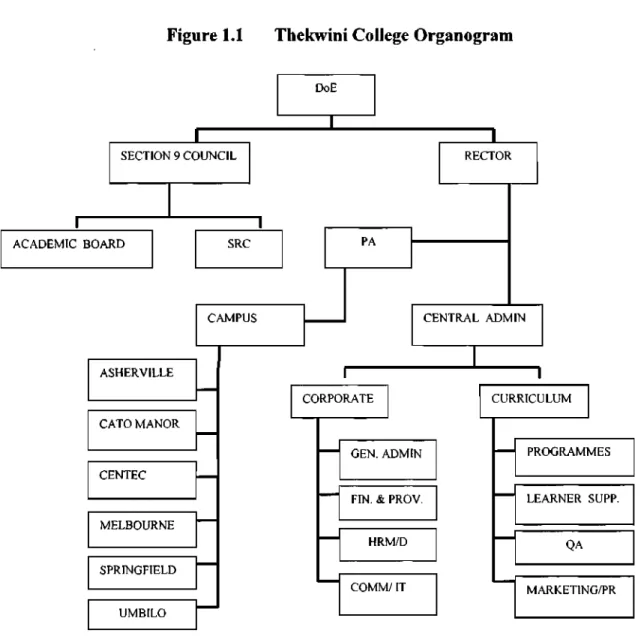
CONTEXT OF THE RESEARCH AND THE PROBLEM STATEMENT
What are the critical success factors for fostering and facilitating a creative climate at Thekwini FET College.
OBJECTIVE OF STUDY
RESEARCH METHODS
By using the Analysis of Written Documents method, the researcher looked at the choice of words, sentences and paragraphs that could motivate or demotivate the employees. Since this study was conducted within a qualitative paradigm, the researcher analyzed the data primarily using the inductive process.
LIMITATIONS OF THE STUDY
For the interview method, the researcher used open-ended questions so that the participants were able to discuss their attitudes, beliefs and practices. The researcher was aware that the fundamental challenge in this study would be to identify creative practices.
STRUCTURE OF THE REPORT This research report is divided into six chapters
CONCLUSION
This chapter provides a conceptual framework of key theories and literature related to creativity, creative climate, and methodological issues associated with identifying perceptions of the climate of creativity in the workplace and factors that either enhance or stifle creativity. Furthermore, it patterns the study through the conceptual problem of how creative climates can be perceived in the workplace.
LITERATURE REVIEW
Informal learning is an indispensable, but very often invisible, part of the organization with the ability to play an active role in workforce development. Learning from experience is fundamental to the way people in the workplace construct meaning and share relationships in the milieu of the organization.
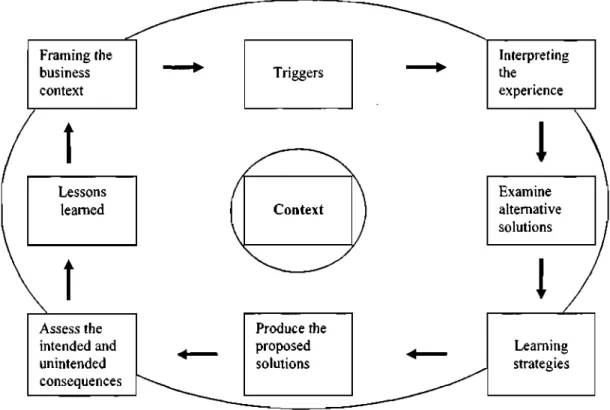
MEANING OF CREATIVITY AND CLIMATE
The literature defines climate as recurring patterns of behavior, attitudes, and feelings that characterize life in the organization. Phenomenologically speaking, it is the individual's perceptions of these conditions, factors and events in the organization that make up the climate.
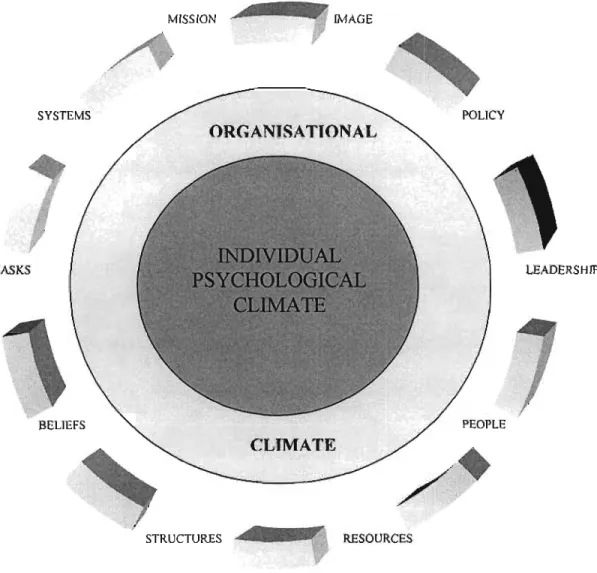
THEORETICAL FRAMEWORK
This early model is the basis for most of the creative thought processes available today. The version of the instrument used in this research is the Creative Climate Questionnaire (CCQ) and it includes ten dimensions.
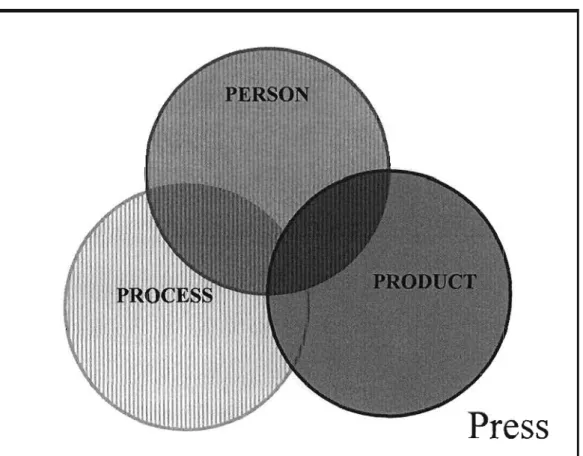
CONCLUSION
In an encouraging atmosphere, bosses and colleagues receive ideas and suggestions in an attentive and friendly manner. The following chapter describes the qualitative research design, including the methods and procedures used in this study.
RESEARCH DESIGN
On reflection, research into the way people learn in the workplace makes it clear that this point is actually an outgrowth of the idea that learning is active and social. Research into how people learn in the workplace shows that what takes place is constructivist (Kerka 1997).
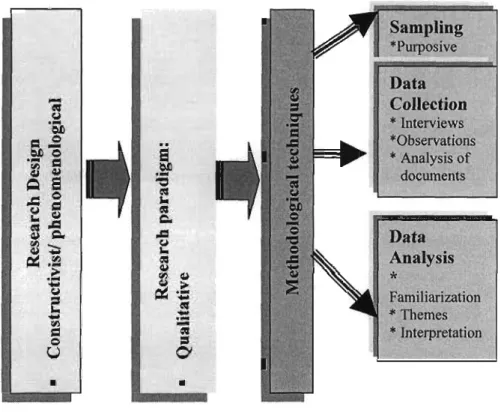
RESEARCH PARADIGM Qualitative Paradigm
The differences mainly stem from the positivist (the belief that the world can be measured, understood and generalized about) perspective of quantitative research versus the constructivist (the belief that the world has different meanings) perspective of qualitative research. An inductive process that reveals patterns that will increase awareness of the participants' experience (methodological assumption).
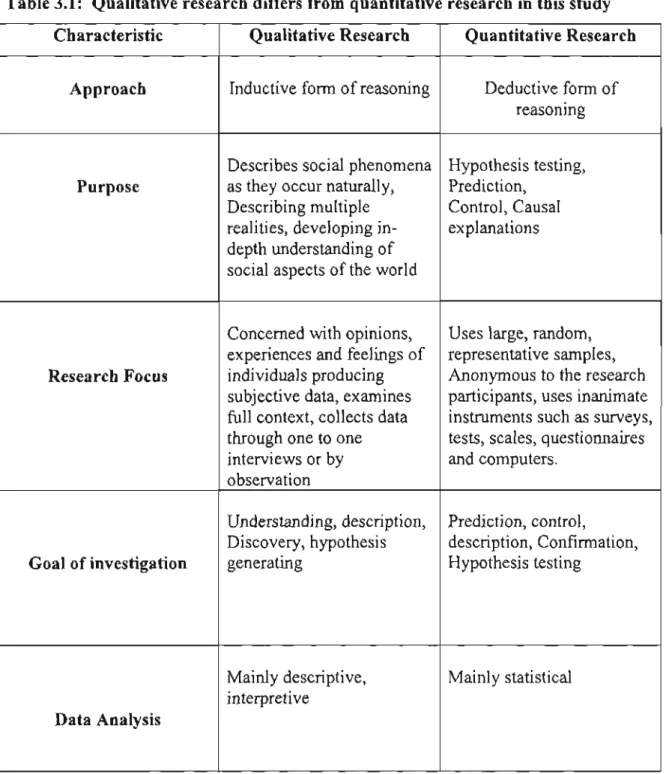
RESEARCH PARTICIPANTS
By making himself aware of the hierarchical context of this organization, the researcher was able to understand the participants' perceptions of the climate for creativity at Thekwini FET College. In the latter type, the researcher has purposefully selected a particular portion of the broader population to include or exclude from the sample. All four participants volunteered to participate in this study after understanding the nature of the research topic.

ETHICAL ISSUES
The researcher's profile and circumstances were disclosed to all participants through oral and written communication. The outcome of the final investigation will be made available to the General Director (Rector) and the College Council. In this way, the researcher could eliminate biases that would not only have influenced the direction of the research, but could also taint this study with the possibility of misjudgments.
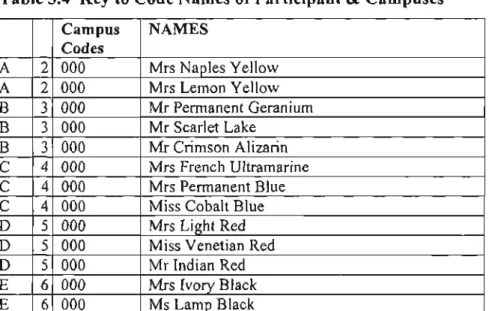
DATA COLLECTION METHODS
In some research, observation of the environment is not required, but observation of the environment. The researcher attended four departmental meetings (one in each department) and sat in places that were not inconvenient for the rest of the participants. By analyzing relevant workplace documents, the perceptions of senior lecturers and lecturers about the climate for creativity in the workplace can be strengthened or undermined.
DATA ANALYSIS
This was very useful as the researcher could read these maps across the entire data set. In the case of this study, the researcher used thematic maps for each theme across all participants. In this study, the researcher was able to move through the stages of Framework Analysis and develop established themes through mapping and mapping exercises.
ENSURING RIGOUR
The research design also introduced internal validity strategies that evaluated the research findings in this study in relation to the reality of the workplace. This confirmed the consistency of the perceptions of a creative climate experienced by the research participants. Did the participants have the opportunity to verify the accuracy/inaccuracy of the researcher's interpretation of their experiences in this study.
LIMITATIONS OF THE STUDY Study
One of the main disadvantages of the interviews conducted in this study was that they were time consuming. Participants were assured of their safety and the safety of the tapes recorded during the interviews. They had expectations that the researcher could mediate on their behalf in some of the department's problems.
CONCLUSION
Beginning with an introduction to a sample profile, the chapter continues with managers' perceptions of the climate for creativity, followed by non-managers' perceptions. The profile of the sample used for the interviews was examined in terms of age, work experience and job title. Given the relatively mature age of the sample, the level of work experience is correspondingly high.
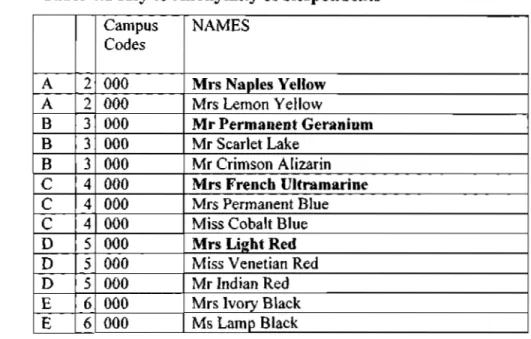
FINDINGS
Evidence from the data collected informed the researcher that the non-managers desired recognition and support for creative work performed in the classroom. They have indicated that they are bound by the requirements of the syllabus and that this is a factor that limits their freedom in the classroom. The researcher found that non-managers were able to adapt to their circumstances and develop mechanisms to implement new ideas in the classroom.
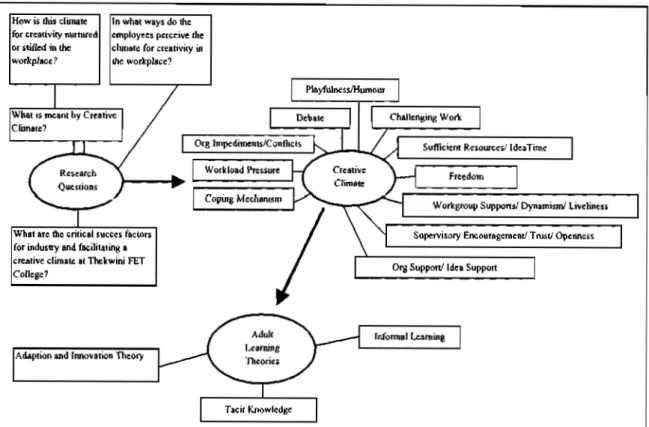
ANALYSIS AND DISCUSSION
Sixty percent of staff were able to use coping mechanisms to exercise their freedom in the classroom. Forty percent of the non-managers indicated that the syllabus and organizational structure limited their freedom in the classroom, while 60 percent of the staff were able to use coping mechanisms in the classroom. Because of the subjective nature of informal socialization, debates cannot be controlled by management in the way that the formal organization can.
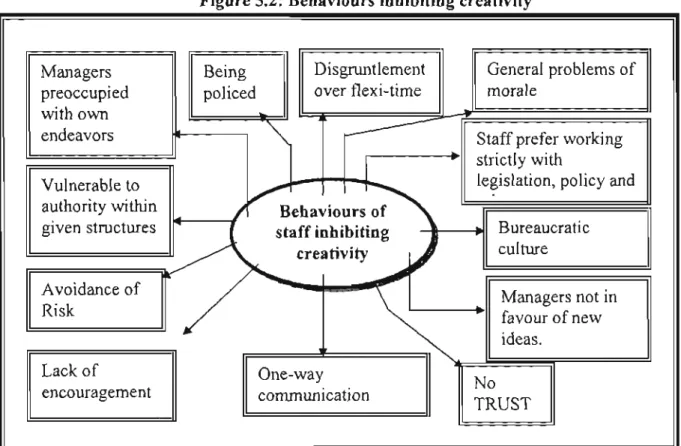
CONCLUSION
It was through the application of the components of these instruments that I was able to conceptualize the meaning of creativity and climate in the context of this study. Therefore, the title, "Perceptions of a climate for creativity", is expected to capture an unbiased view of the managers' and non-managers' experiences in their workplace. Chapter Two explored the importance of the conceptual framework of key theories and literature related to the climate for creativity.
RECOMMENDATIONS
The sub-questions were: (3) What is meant by a 'creative climate'. 4) What are the critical success factors for inducing and facilitating a creative climate at Thekwini FET College. In summary, this study aimed to describe the perceptions of employees (i.e. managers and non-managers) regarding the climate for creativity at Thekwini FET College. This chapter recommends, shares, and reveals hidden practices that are effective in engendering and facilitating a positive creative climate.
Improve the organisational culture at Thekwini College
The discussion on the climate dimensions mutually influence each other and are therefore closely linked in the following recommendations. The following recommendations arose from the results of the analysis and discussion in the previous chapter. To create a synergy through effective, timely communication between employees. The literature in this study points out that sharing information in the workplace is considered to be the lifeblood of the organization.
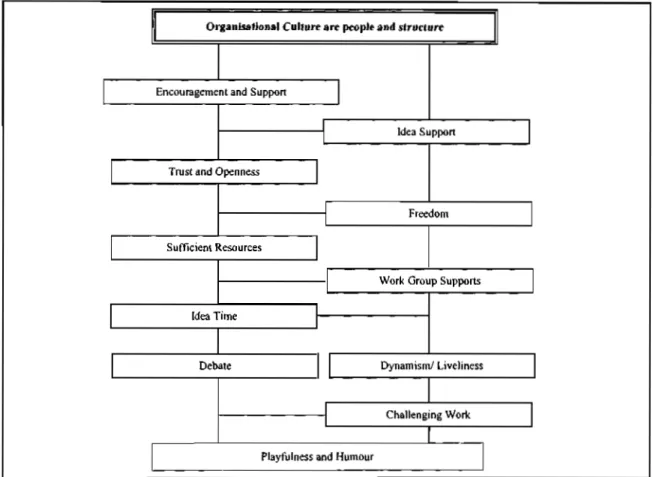
Acknowledging the benefits of socialisation
- CONCLUSION
Available: file://www. 2001, 'How to kill creativity', in Creative Management, ed. 2004, Dissecting the Urge to Create, [online]. Available:file://www.24 May 2004 1 Creativity in Social Networks Combining Knowledge in Innovations_ Arent —html [2005, Jan. Available: file://www. Enhancing%20Organisational%20Creativity%20Through%20Socilisation.html[2005, Jun.02]. ed.) 1991, Creative Management, SAGE Publications, London.
SCHEDULE OF QUESTIONS FOR INTERVIEWING MANAGERS
- Organisational encouragement and support
- Supervisory encouragement
- Work group supports
- Freedom
- Sufficient Resources
- Challenging Work
- Organisational Impediments
- Workload Pressure
- Describe two critical work incidents, one involving high creativity and the other involving low creativity in your department
- Would your department be better off if staffs creative energy could be re- focused in highly productive ways? How?
- How do you foster creativity in your department?
- As a manager how do you reconcile the staff creative need for participation and informal communication with the opposing management need for
- Do you think that creativity in the workplace is important?
Describe two critical work incidents, one involving high creativity and the other involving low creativity in your department, another involving low creativity in your department. Would your department be better off if staff creative energy could be refocused in highly productive ways. As a manager, how do you reconcile the staff's creative need for participation and informal communication with the opposing management need for and informal communication with the opposing management need for hierarchy and structured authority.
SCHEDULE OF QUESTIONS FOR INTERVIEWING STAFF
Or does the job give/deny you any chance to use initiative or personal judgment in doing the job. When you think about your job and work environment, do you see more positives than negatives or more negatives than positives? To what extent does doing the work itself provide you with information about your job performance?
APPENDIX C
SCHEDULE OF CRITERIA TO BE USED DURING OBSERVATIONS
The following chart, inspired by Ferguson (1987), describes the old and new paradigms of organizational culture, which maintains the new paradigm of shared staff values. As the discussion of participants' thematic responses confirmed the old value paradigm, Thekwini FET College aims to apply and manage the new value paradigm in order to create a more creative environment for its employees.
